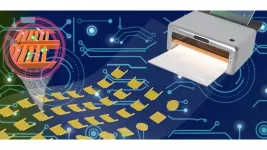(Press-News.org) MORGANTOWN, W.Va. -- Imagine being woken up at 3 a.m. to navigate a corn maze, memorize 20 items on a shopping list or pass your driver's test.
According to a new analysis out of West Virginia University, that's often what it's like to be a rodent in a biomedical study. Mice and rats, which make up the vast majority of animal models, are nocturnal. Yet a survey of animal studies across eight behavioral neuroscience domains showed that most behavioral testing is conducted during the day, when the rodents would normally be at rest.
"There are these dramatic daily fluctuations--in metabolism, in immune function, in learning and memory, in perception--and by the large, they get ignored," said Randy Nelson, who led the study. "You just have to wonder: to what extent is that affecting the outcomes?"
Nelson chairs the School of Medicine's Department of Neuroscience and directs basic science research for the Rockefeller Neuroscience Institute.
His findings appear in Neuroscience and Behavioral Reviews.
Nelson and his colleagues--RNI researchers Jacob Bumgarner, William Walker and Courtney DeVries--examined the 25 most frequently cited papers in each of eight categories of rodent behaviors: learning and memory, sensation and perception, attention, food intake, mating, maternal behavior, aggression and drug seeking.
For each study, they determined whether the behavioral testing was done during the day, at night, or both. They also identified which studies reported time-of-day information ambiguously or not at all.
Overall, only 20% of the studies reported nighttime testing. Seventeen percent reported daytime testing, and 7.5 percent reported both. The remainder of the studies either didn't mention when testing occurred (42%) or were ambiguous on that point (13.5%).
Even among the studies conducted at night, most didn't describe in detail how the authors protected the rodents' circadian rhythms. For example, at what times did the researchers observe the animals? Did they house the animals in the dark during the day? If so, how did they keep extraneous light from invading the room every time someone opened the door or turned on a hallway light? In most cases, it's impossible to tell from the methods section.
Yet recording this kind of information is crucial to a study's reproducibility. Without knowing how an experiment was run the first time, other scientists can't run it again to see if they get different results. And running experiments multiple times--under different conditions--is the basis of all scientific inquiry.
"We want to make sure everyone's conducting and reporting the best science they can do," Nelson said. "This is important because, in common with the NIH, we want to improve the rigor and reproducibility of science."
Failing to account for time of day doesn't just jeopardize an animal study's reproducibility. It can also make its results less applicable to humans.
Being diurnal, humans tend to be active when the sun is up and rest when it's down. That's the opposite of the nocturnal rodents that scientists common use in biomedical studies. If the scientists disregard this discrepancy, it can reduce the value of their data when they try to extrapolate their results to humans.
"If you're testing a mouse during the middle of its active period, which is during the dark, you can translate those data to a diurnal creature who's active during that time," Nelson said. "I think that's fine."
But in the light, a mouse's daytime behavior is less comparable to a person's.
"It's like waking you up at 3 in the morning and saying, 'OK, let's walk a tightrope,' and then you're no good at it," he said. "Well, what a surprise."
So, how can a diurnal, human researcher design and carry out a study of nocturnal rodents when their circadian rhythms naturally conflict?
One step she can take is to reverse the rodents' light/dark cycle by housing the animals in total darkness during the day and turning on the lights at night. This way, she and her colleagues get to observe the animals during their active phase--under simulated "nighttime" conditions--without driving to the lab at midnight.
When researchers check on the animals in the daytime, they can do so under dim red lighting instead of regular, white lighting. To complete the effect, windows can even be tinted with a red film. Rodents can't see red light, so it won't disrupt their circadian rhythms.
Some labs come equipped with red overhead lighting, but even if researchers can't access such a space, there are ways around the problem.
"You can use a miner's light with a little, red light in it," Nelson said. "That works really well."
Night-vision goggles are another option.
In any event, recording these measures--in detail--is key.
"The goal of this paper is to make sure that we raise consciousness about it in the same way that people raised consciousness about sex as a biological variable that's important," Nelson said. "Everybody knows it, but--as a group of biomedical researchers--we ignore it. And if you ignore it, then can you really translate those data on a nocturnal animal to a diurnal animal when you're testing at the wrong time of day?"
INFORMATION:
Philadelphia, June 10, 2021 - The collection of nasopharyngeal swab (NPS) samples for COVID-19 diagnostic testing poses challenges including exposure risk to healthcare workers and supply chain constraints. Saliva samples are easier to collect but can be mixed with mucus or blood, and some studies have found they produce less accurate results. A team of researchers has found that an innovative protocol that processes saliva samples with a bead mill homogenizer before real-time PCR (RT-PCR) testing results in higher sensitivity compared to NPS samples. Their protocol appears in The Journal of Molecular Diagnostics, published by Elsevier.
"Saliva as a sample type for COVID-19 testing ...
WASHINGTON, June 10, 2021 -- The demand for flexible wearable electronics has spiked with the dramatic growth of smart devices that can exchange data with other devices over the internet with embedded sensors, software, and other technologies. Researchers consequently have focused on exploring flexible energy storage devices, such as flexible supercapacitators (FSCs), that are lightweight and safe and easily integrate with other devices. FSCs have high power density and fast charge and discharge rates.
Printing electronics, manufacturing electronics devices and systems by using conventional printing techniques, has proved to be an economical, simple, and scalable strategy for fabricating FSCs. Traditional micromanufacturing ...
An exploratory investigation into the behavior of materials with desirable electric properties resulted in the discovery of a structural phase of two-dimensional (2D) materials. The new family of materials are electrides, wherein electrons occupy a space usually reserved for atoms or ions instead of orbiting the nucleus of an atom or ion. The stable, low-energy, tunable materials could have potential applications in nanotechnologies.
The international research team, led by Hannes Raebiger, associate professor in the Department of Physics at Yokohama National University in Japan, published their results on June 10th as frontispiece in Advanced Functional Materials.
Initially, the team ...
Researchers from Skoltech have designed and conducted experiments measuring gas permeability under various conditions for ice-containing sediments mimicking permafrost. Their results can be useful both in modeling and testing techniques for gas production from Arctic reservoirs and in tracing methane emission in high latitudes. The paper was published in the journal Energy&Fuels.
Permafrost, even though it sounds very stable and permanent, is actually quite diverse: depending on the composition of the frozen ground, pressure, temperature and so on, it can have varying properties, which are extremely important if you want to build something on permafrost, ...
GRAND RAPIDS, Mich. (JUNE 10, 2021) -- Much like a supply truck crossing the countryside, the misfolded proteins that damage neurons in Alzheimer's disease travel the "roads" of the brain, sometimes stopping and sometimes re-routing to avoid roadblocks, reports a study published in END ...
MELVILLE, N.Y., June 10, 2021 -- The physiological impacts of COVID-19 seem almost limitless. Complications can range from loss of taste to respiratory distress, with many effects lasting for months. Evidence suggests auditory and vestibular effects should be added to the growing list of symptoms.
During the 180th Meeting of the Acoustical Society of America, which will be held virtually June 8-10, Colleen Le Prell, from the University of Texas at Dallas, will talk about hearing and balance disorders associated with coronavirus infection and how pandemic-related stress ...
Paris, France and New York, NY June 10, 2021 - AP-HP Greater Paris University Hospitals, the leading European clinical trial center with the largest amount of healthcare data in France dedicated to research and Owkin, a startup pioneering Federated Learning and AI technologies for medical research and clinical development, announced the recent results of their ongoing strategic collaboration at ASCO 2021. The abstract and poster entitled "Identification of pancreatic adenocarcinoma molecular subtypes on histology slides using deep learning models" demonstrates the first ...
ROCKVILLE, Md. - June 10, 2021 - The Association for Molecular Pathology (AMP), the premier global, molecular diagnostic professional society, today published consensus recommendations to aid in the design and validation of clinical CYP2D6 assays, promote standardization of testing across different laboratories and improve patient care. The manuscript, "Recommendations for Clinical CYP2D6 Genotyping Allele Selection: A Joint Consensus Recommendation of the Association for Molecular Pathology, College of American Pathologists, Dutch Pharmacogenetics Working Group of the Royal Dutch Pharmacists Association, and European Society for Pharmacogenomics and Personalized Therapy," was released online ahead of publication in The Journal ...
Champaign, IL, June 10, 2021 - Present in blood, urine, and milk, the chemical compound urea is the primary form of nitrogen excretion in mammals. Testing for urea levels in dairy cows helps scientists and farmers understand how effectively nitrogen from feed is used in cows' bodies, with important economic implications for farmers in terms of feed costs, physiological effects for cows such as reproductive performance, and environmental impacts from excretion of nitrogen in dairy cow waste. Thus, accuracy in testing dairy cow urea levels is essential.
Since the 1990s, mid-infrared testing of milk urea nitrogen (MUN) has been the most efficient and least invasive way to measure nitrogen use by dairy cows in large numbers. In a recent ...
Plastic bottles drifting in the sea; bags in the stomachs of turtles; Covid-19 masks dancing in the surf: few images are as unpleasant to look at as those that show the contamination of our oceans. And few environmental issues are as urgent and as present in the public awareness. "Most people have an emotional connection to the sea. They think of ocean pollution as an attack on a place they long for," said Nikoleta Bellou, marine scientist at Hereon's Institute of Coastal System - Analysis and Modeling. Between 1990 and 2015 alone, an estimated 100 million metric tons of mostly plastic waste entered the oceans. For that instance the study fits to the UN Decade of Ocean Science for Sustainable Development, which started this year to emphasize a sustainable use of ...




